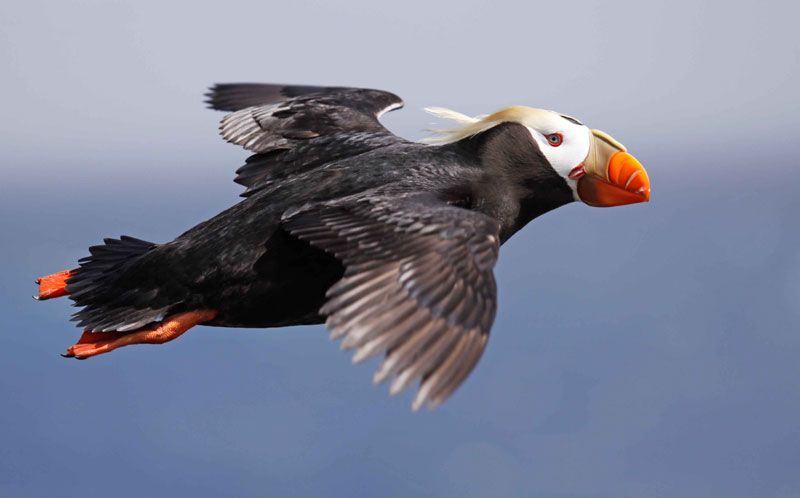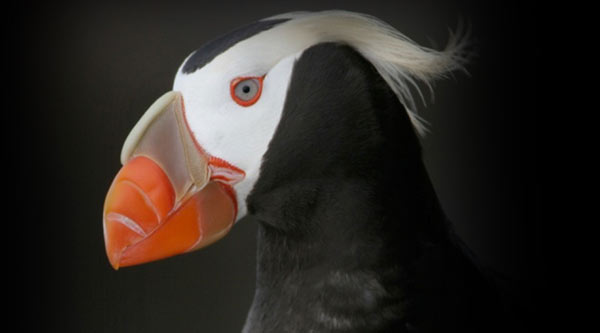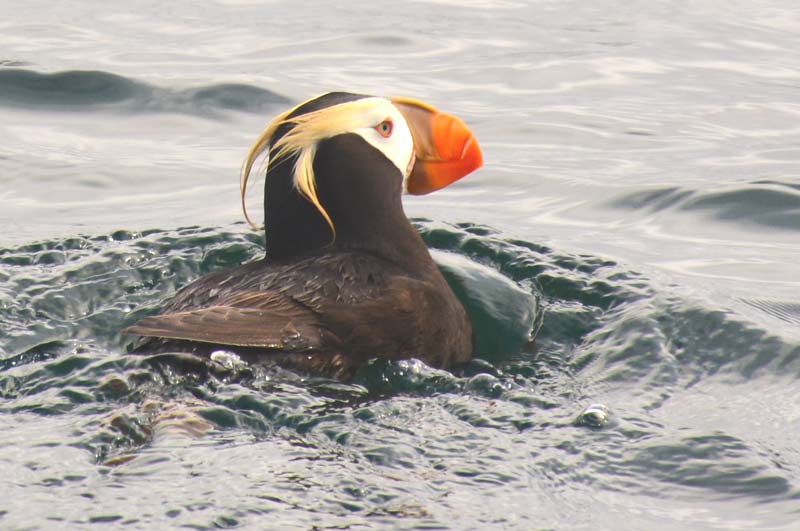Bid Farewell to Puffins Event at Cannon Beach, Aug. 22 | N. Oregon Coast
Published 08/10/21 at 6:19 PM PDT
By Andre' GW Hagestedt

Includes exclusive listings; some specials in winter
In Cannon Beach:
Includes rentals not listed anywhere else
In Manzanita, Wheeler, Rockaway Beach:
Some specials for winter
In Pacific City, Oceanside:
Some specials for winter
In Lincoln City:
Some specials for winter
In Depoe Bay, Gleneden Beach:
Some specials for winter
In Newport:
Look for some specials
In Waldport
Some specials for winter
In Yachats, Florence
Some specials for winter
Southern Oregon Coast Hotels / Lodgings
Reedsport to Brookings, places to stay; winter deals
(Cannon Beach, Oregon) – Your chances to see the puffins atop one Oregon coast landmark are quickly coming to an end. (Photo courtesy Friends of Haystack Rock)
With this in mind, the Friends of Haystack Rock will be offering one last blast for puffin fans with a guided puffin watch event on August 22, out in front of Cannon Beach's Haystack Rock. It happens 8 a.m. to 11 a.m.
There, volunteers with the organization will be out on the beach with birding scopes to share.
Tiffany Boothe, one of the heads of Friends of Haystack Rock, said right about the end of August or so they begin leaving the iconic north Oregon coast rock after having hatched and raised their young there since spring.
“The puffins typically leave Haystack Rock the last week of August through the first week of September,” Boothe said. “To avoid predators they leave their burrows at night. So one day you'll see them up on the Rock and then the next day they are all gone.”
Boothe said you're starting to see clear signs their parenting time is coming to an end.
“They have been very active lately, as they prepare their chick to fledge,” she said. “You can see the puffins as they fly in and out of their burrows with food for their growing chick.”
So, the event is basically bidding farewell to the favorite north Oregon coast bird, at a spot that is the largest tufted puffin breeding locale in the state.
“In early April puffins show up at Haystack Rock,” Boothe said. “Most of the puffins have already found their lifelong partners and are returning to the same protected burrow they used last year to raise their young.”
For the first two weeks, the happy couple stakes out their territory on top and clean out their burrow. Once that is done, the female puffin will lay one egg that is about the size of a chicken egg, and both male and female puffin incubate the egg. This usually lasts about 41 – 54 days, with the family spending a total of 16 weeks or so at the rock.
“Though usually tucked back inside the burrow, newly hatched puffins appear at the ‘Rock' beginning in late June through mid to late August,” Boothe said. “Despite the fact that you may not be able to see the pufflings, activity around the rock is hectic and plentiful: it is fun to observe the parent puffins making multiple trips to their burrow with bills full of fish for their young.”
Pufflings leave their burrows some 38 to 59 days after hatching, Boothe said. When each leaves, they head back out to the open ocean for the winter.
Boothe said bald eagles are one of the biggest predators, which is primarily who they're avoiding by heading out at night.
The tufted puffin is a major icon of this iconic north Oregon coast rock, yet in recent decades their numbers are decreasing in Oregon, including Haystack Rock, as well as California, Washington, Japan, and the Gulf of Alaska. They've even completely disappeared from some of those colonies, including one that was well known at Heceta Head.
It's something Boothe and the Friends of Haystack Rock have taken on as an issue.
“All over the world puffin populations are in trouble,” Boothe said. “We are trying to help spread the word and educate people about their population problems and what we can do to help. Education and research is needed to save this amazing bird.”
Also see Tufted Puffins Return to Oregon Coast - Cannon Beach, Bandon, Coos Bay
Hotels in Cannon Beach - Where to eat - Cannon Beach Maps and Virtual Tours
 Cannon Beach Vacation Rentals. About 60 vacation homes to choose from: ocean view, oceanfront and very close to the beach, all in Cannon Beach or in Arch Cape. All are either oceanfront or very close. Homes sleep as many as 12. 164 Sunset. Cannon Beach, Oregon. 503-436-0940. 866-436-0940. www.visitcb.com
Cannon Beach Vacation Rentals. About 60 vacation homes to choose from: ocean view, oceanfront and very close to the beach, all in Cannon Beach or in Arch Cape. All are either oceanfront or very close. Homes sleep as many as 12. 164 Sunset. Cannon Beach, Oregon. 503-436-0940. 866-436-0940. www.visitcb.com  Beachcomber Vacation Homes. Numerous vacation rentals in the Cannon Beach area, including Falcon Cove and Arch Cape. Depending on the home, you may find amenities and luxuries such as a barbecue, claw foot tub, a ship's ladder. 115 Sunset Blvd. Cannon Beach, Oregon. 855-219-4758. 503-436-4500. Website.
Beachcomber Vacation Homes. Numerous vacation rentals in the Cannon Beach area, including Falcon Cove and Arch Cape. Depending on the home, you may find amenities and luxuries such as a barbecue, claw foot tub, a ship's ladder. 115 Sunset Blvd. Cannon Beach, Oregon. 855-219-4758. 503-436-4500. Website.
Cannon Beach Lodging
Nehalem Bay Lodgings
Manzanita Hotels, Lodging
Three Capes Lodging
Pacific City Hotels, Lodging
Lincoln City Lodging
Depoe Bay Lodging
Newport Lodging
Waldport Lodging
Yachats Lodging
Oregon Coast Vacation Rentals
Oregon Coast Lodging Specials
More About Oregon Coast hotels, lodging.....
More About Oregon Coast Restaurants, Dining.....
 Andre' GW Hagestedt is editor, owner and primary photographer / videographer of Oregon Coast Beach Connection, an online publication that sees nearly 1 million pageviews per month. He is also author of several books about the coast.
Andre' GW Hagestedt is editor, owner and primary photographer / videographer of Oregon Coast Beach Connection, an online publication that sees nearly 1 million pageviews per month. He is also author of several books about the coast.
LATEST Related Oregon Coast Articles
Through 2 a.m. likely best, but some lights possible through dawn June 1 - 2. Space weather, astronomy
Rare Sperm Whale Stranding on N. Oregon Coast, Was Hit by Boat
Showing up near Gearhart, it will decompose naturally. Marine sciences
Coast Guard Barque 'America's Tall Ship' Coming to Portland Rose Fest, N. Ore...
Portland events: June 5 - 8; Astoria events June 13 - 15. Weather
Bright and Active Arietids Meteors May Hit Pre-Dawn Hours of Oregon, Washingt...
Look to east hour before sunrise and you may catch a show. Sciences, astronomy, weather
Why Now Could Be a Great Week for Spotting Killer Whales on Oregon Coast - Video
A good dozen documentations around Depoe Bay, Newport, Coos Bay, Bandon, Tillamook. Marine sciences
Summer Road Work, Traffic Issues Along Oregon Coast Include Astoria, Garibald...
Some daylight closures include bridges, OR 22, OR 18, OR 26, more. Travel tips. Seaside, Cannon Beach, Lincoln City. Travel tips
Pacific City Oregon Weather, 7-Day Forecasts, Live Conditions, Radar, Webcams...
Updated Constantly: Pacific City, Tierra Del Mar, Oregon Weather, Cams, Buoy Observations, Tides, Warnings - Alerts
Oregon Coast Has World's Oldest Harbor Seal, Celebrating 50 Years Soon
June 3 at Oregon Coast Aquarium in Newport. Newport events
Back to Oregon Coast
Contact Advertise on BeachConnection.net
All Content, unless otherwise attributed, copyright BeachConnection.net Unauthorized use or publication is not permitted
























































